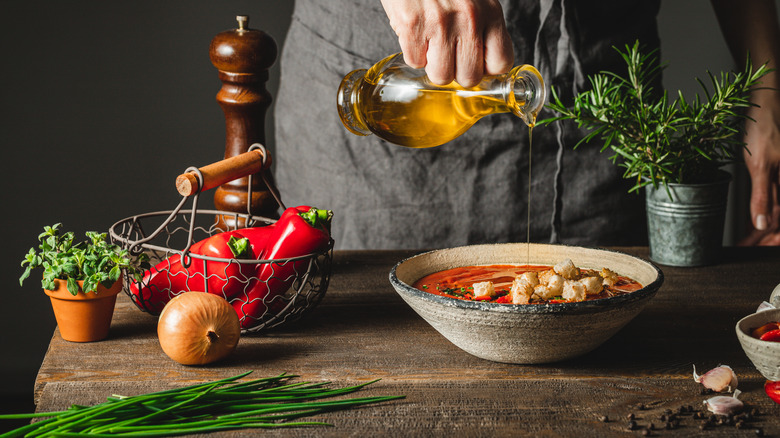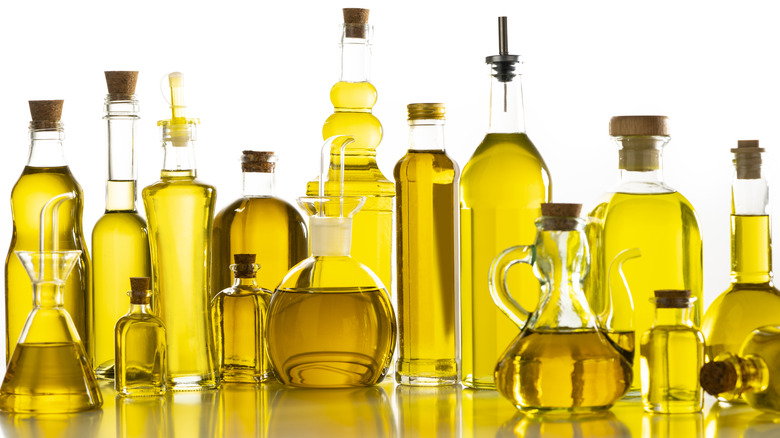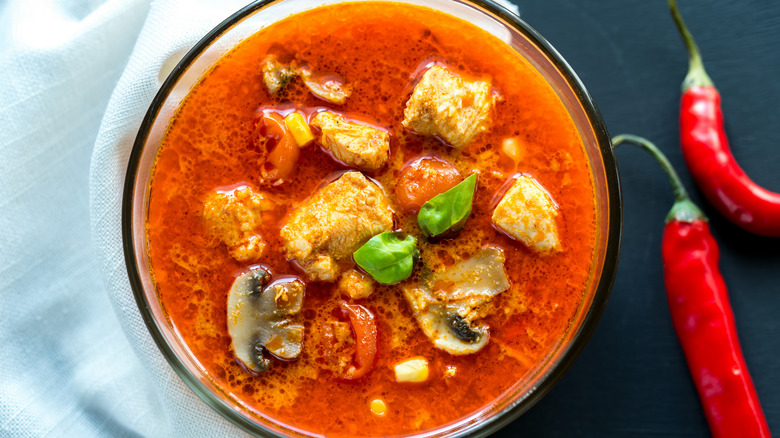The Oil Trick To Fix Your Soup If It's Too Spicy
Soup can accidentally turn out spicy for a number of reasons. Perhaps you added too much cayenne powder, haven't built up your spice tolerance, or maybe underestimated the heat level of the chile peppers you used. It could even be a matter of forgetting to taste your soup as you cook it. Luckily there are plenty of methods to tame food that's too spicy. Dairy can be added to any spicy dish to tone down the heat, a bit of sugar or sweetener can have a similar effect, or you can increase the amounts of the other ingredients to mask the spice. While these solutions are perfectly effective, you may want to consider adding cooking oil before trying anything else. Unlike adding sugar, which may add sweetness to your soup, or adding dairy (such as sour cream), which could introduce some tanginess, oil has a more neutral flavor.
If you're concerned about it making your soup too greasy, don't worry, because you have the option to remove the oil once it's done its job. Start by pouring a cup of oil into your pot of soup, then boil it and let it cool. Once cooled, the oil will collect on the top of the soup. You can either remove this oil or serve it immediately. Once you taste your soup, it'll be noticeably less spicy than it started. But how does oil accomplish this?
How it works
Being able to reduce the spiciness of a soup simply by adding oil and then removing it might seem too good to be true, but there's a reason it works so well. It all comes down to capsaicin, the substance responsible for the heat in spicy foods. When capsaicin comes in contact with certain flavor receptors in your mouth, it activates a response that causes physical sensations such as the heat, tingling, and burning that we associate with spicy foods.
So what does this have to do with cooking oil? Well, capsaicin is fat-soluble, meaning it dissolves in fats and oils much more readily than water. (This is also why drinking water doesn't usually help when you try to cool your mouth down after eating spicy food.) Oil attracts capsaicin, so adding oil to an overly spicy soup causes some of the capsaicin to move into the oil and break down, reducing the perception of spiciness. This effect isn't limited to oil either; you can achieve similar results with any high-fat ingredient, such as nut butter.
Tips for fixing spicy soup with oil
When it comes to removing the oil from your pot, you should be able to skim it off the surface once it cools after coming to a boil. However, another hack for removing oil, according to TikTok at least, is to use a soup ladle filled with ice. This method involves running the bottom of the ice-filled utensil over the surface of the soup. The oil will stick to the ladle and you can easily wipe it off and repeat until you remove the desired amount of fat from your soup.
@problemsolved An easy way to degrease your soup.🍲 #soup #problemsolved #kitchenhacks #lifehacks #cooking #food #recipes #cooktok
If your soup is still too spicy after adding oil, you can always repeat the process until you're satisfied with the level of heat. However, if you don't like the idea of dumping even more oil into your soup, you can always finish the job with milk, another ingredient that counteracts capsaicin. Instead of dissolving the capsaicin, a protein found in milk called casein binds with it, reducing its concentration on your taste buds. Therefore, any remaining capsaicin that wasn't dissolved by the oil can be neutralized by the milk. Just keep in mind that milk doesn't separate from soup as oil does, so you won't be able to skim it off, and it may slightly dilute the soup depending on the quantity you use. It's a good idea to start with oil since it's already very effective at removing capsaicin, so don't be afraid to use more if your soup is very spicy.


